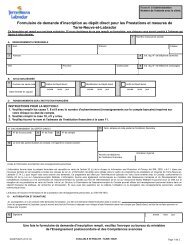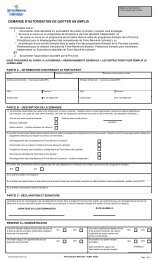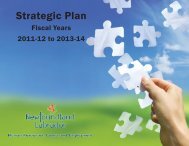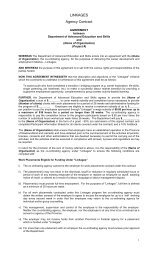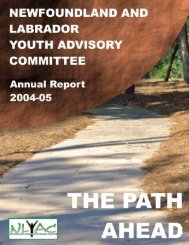Report - Department of Advanced Education and Skills ...
Report - Department of Advanced Education and Skills ...
Report - Department of Advanced Education and Skills ...
Create successful ePaper yourself
Turn your PDF publications into a flip-book with our unique Google optimized e-Paper software.
Canada-Newfoundl<strong>and</strong> <strong>and</strong> Labrador Labour Market Agreement for Persons with Disabilities (LMAPD)Background<strong>Report</strong> 2010-2011In December 2003, Federal/Provincial/Territorial/Ministers Responsible for Social Services approved the MultilateralFramework for Labour Market Agreements for Persons with Disabilities. The goal <strong>of</strong> the Framework is to improve theemployment situation for persons with disabilities within Newfoundl<strong>and</strong> <strong>and</strong> Labrador. This goal will be fulfilledthrough the pursuit <strong>of</strong> the following three objectives; enhancing the employability <strong>of</strong> persons with disabilities,increasing the employment opportunities available to them, <strong>and</strong> building on the existing knowledge base. Additionally,governments have identified the following five priority areas for action: education <strong>and</strong> training, employmentparticipation, employment opportunities, connecting employers <strong>and</strong> persons with disabilities <strong>and</strong> building knowledge.The LMAPD is the successor agreement to the Canada-Newfoundl<strong>and</strong> <strong>and</strong> Labrador Employability Assistance forPeople with Disabilities (EAPD) Agreement <strong>and</strong> came into effect April 1, 2004. This agreement had effect from April1, 2004 to March 31, 2006 <strong>and</strong> has been extended to March 31, 2013.Societal IndicatorsNewfoundl<strong>and</strong> <strong>and</strong> Labrador, signifies a diverse population <strong>of</strong> working-age persons with disabilities representing avariety <strong>of</strong> skills, abilities <strong>and</strong> needs. More than 10% <strong>of</strong> the population lives with a disability. Our province <strong>and</strong> ourcommunities are enhanced by the diverse perspectives, skills <strong>and</strong> talents that citizens with disabilities contribute. Thecommunity <strong>of</strong> persons with disabilities provides input on issues related to disability <strong>and</strong> strong partnerships have beendeveloped between stakeholders <strong>and</strong> government providing opportunities for collaboration on initiatives to promotethe full inclusion <strong>of</strong> persons with disabilities. The development <strong>of</strong> the Multilateral Framework for Persons withDisabilities also provides an opportunity to strengthen our programs <strong>and</strong> services. Over the course <strong>of</strong> this agreementgovernment continues to engage the community to review current programs <strong>and</strong> services <strong>and</strong> to identify new initiativesin an effort to ensure the effectiveness <strong>and</strong> efficiency <strong>of</strong> existing services <strong>and</strong> to respond to gaps identified.As part <strong>of</strong> the ongoing effort <strong>of</strong> government to provide information to its citizens on programs <strong>and</strong> services providedunder the LMAPD, a number <strong>of</strong> societal indicators <strong>of</strong> labour market participation have been identified. Commonindicators include:1. Employment rate <strong>of</strong> working age persons with disabilities;2. Employment income; <strong>and</strong>3. <strong>Education</strong> attainment.The 2004 baseline report presented societal indicators using data from the Participation <strong>and</strong> Activity Limitation Survey(PALS), Canada’s principal source <strong>of</strong> detailed statistical information about disability issues. PALS was first conductedin 2001 <strong>and</strong> again following the 2006 census. This year’s report uses the Statistics Canada survey, the Survey <strong>of</strong>Labour <strong>and</strong> Income Dynamics (SLID), to present societal indicators. SLID is conducted annually <strong>and</strong> providesinformation about income, employment, education <strong>and</strong> other topics for the adult Canadian population.2







